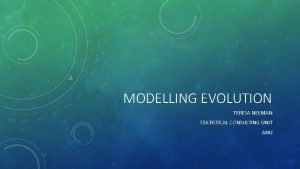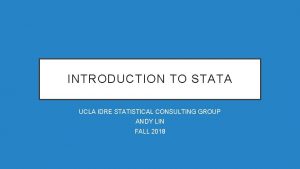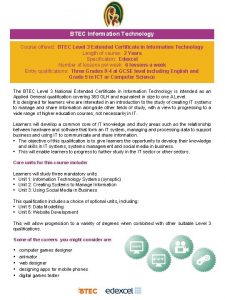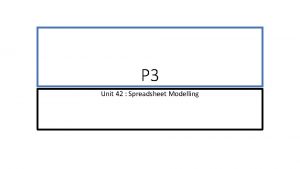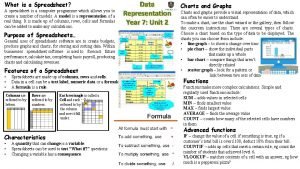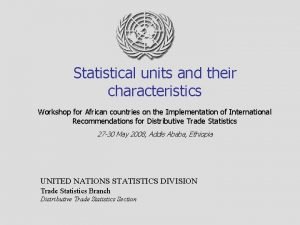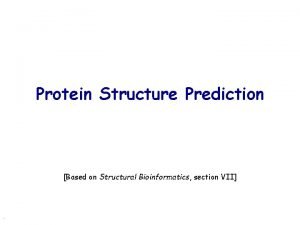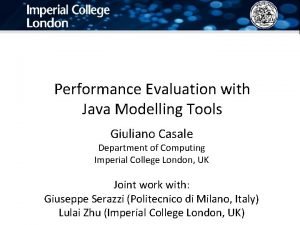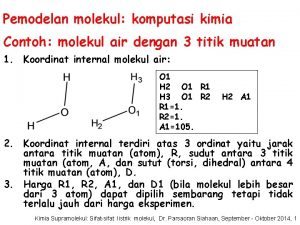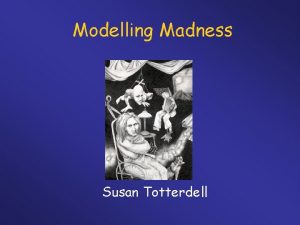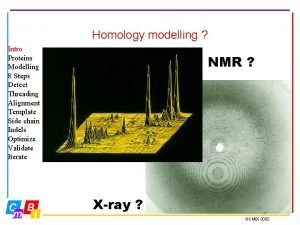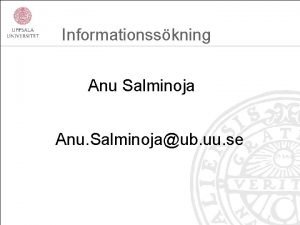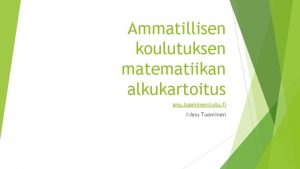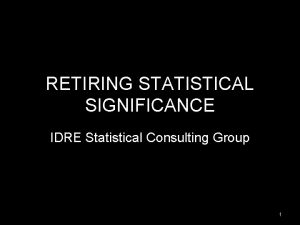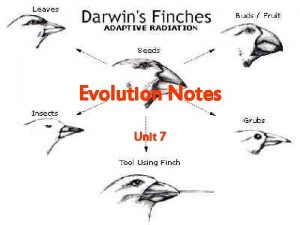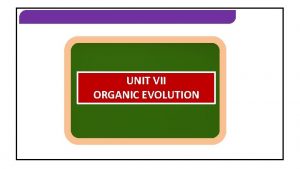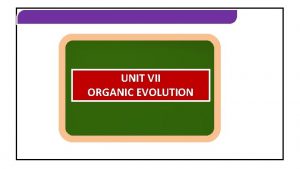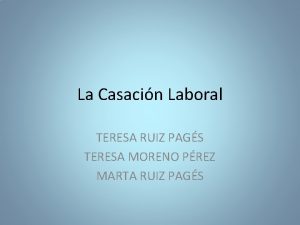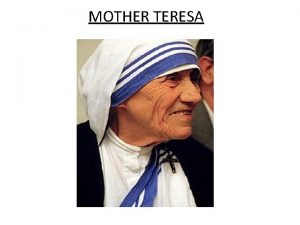MODELLING EVOLUTION TERESA NEEMAN STATISTICAL CONSULTING UNIT ANU




















- Slides: 20

MODELLING EVOLUTION TERESA NEEMAN STATISTICAL CONSULTING UNIT ANU

DRIVERS OF EVOLUTION: RANDOM PROCESS + SELECTION/ADAPTATION Bacteria undergo hypermutation in response to stress Adaptive immune system undergoes somatic hypermutation to mount a specific immune response

DERIVING STOCHASTIC MODELS OF MOLECULAR EVOLUTION COMPARE HOMOLOGOUS GENES ACROSS SPECIES USING SEQUENCE ALIGNMENTS

PHYLOGENETICS: TOOL FOR MODELLING EVOLUTION • What is the evolutionary relationship between a set of taxa? (identify the tree) • Given a tree, what is the evolutionary distance along the branches?

CONTINUOUS TIME MARKOV PROCESSES TO MODEL MOLECULAR EVOLUTION • Underlying substitution rate matrix Q • Initial nucleotide distribution, e. g. π = (. 25, . 25) Up to 12 free parameters

A BRIEF HISTORY OF CONTINUOUS TIME MARKOV PROCESSES FOR MODELLING EVOLUTION Model Substitution Rate #Parameters • Jukes-Cantor(1969) all equal • Kimura (1980) transitions > transversions 1 2 • Felsenstein (1981) estimate initial state 3 • Gen. Time-reversible (1986) exchangeable 9

PROPERTIES OF ALL OF THESE MODELS • Stationarity: the distribution of bases (A, C, G, T) unchanged over evolutionary time • Time-reversibility: the process looks the same whether run forwards or backwards

NESTED MODELS IN COMMON MODELS OF EVOLUTION 2 df 1 df Kimura(1980) Jukes-Cantor(1969) 5 df HKY(1984) Felsenstein(1981) 3 df 9 df GTR(1986) ? (4^k -1) df DATA (sufficient statistic)

ASSESSING AN EVOLUTIONARY MODEL Choice of model should reflect evident patterns in data Stationary models: A/C/G/T content should be similar across taxa Note: time reversible models are stationary Models should “fit” the data Likelihood ratio tests against the “saturated model” GOLDMAN, N. 1993. Statistical tests of models of DNA substitution. J Mol Evol, 36, 182 -98

FULLY GENERALISED CONTINUOUS TIME MARKOV MODEL • 12 free parameters for each edge • Initial nucleotide distribution, to be estimated by the data Up to 12 free parameters

COMPARING NESTED MODELS IN 3 -TAXA (UNROOTED) TREE 4000 SEQUENCE ALIGNMENTS (NUCLEUS) HUMAN TIME-REVERSIBLE Q (GTR) 9 df MOUSE QH QM Q Q GENERAL MODEL QH, QM, QO 39 df QO Q “FULLY SATURATED” MODEL OPOSSUM (MULTINOMIAL) 63 df KAEHLER, B. et al 2015. Genetic distance for a general non- stationary markov substitution process. Syst Biol, 64, 281 -93

HOW OFTEN ARE THE MARKOV MODELS “ADEQUATE” RELATIVE TO THE SATURATED MODEL? “ADEQUATE” = LIKELIHOOD RATIO TEST (p >0. 05) • GENERAL MODEL – 94% • TIME-REVERSIBLE MODEL - 18% The saturated model can be approximated using a Markov model!

MODEL FIT VS MODEL COMPLEXITY MARKOV MODELS WITH N TAXA: • GTR model: 9 free parameters • General model: (2 N-3)*12 + 3 free parameters • Can we reduce the model complexity without sacrificing model fit?

DATA: SUBSTITUTION RATE ESTIMATES FOR 4000 NUCLEAR SEQUENCE ALIGNMENTS: 12000 X 12 Gene edge T. A T. G C. T C. A etc. 1 MOUSE 0. 37 0. 06 0. 04 0. 10 2 MOUSE 0. 24 0. 14 0. 04 0. 58 1 HUMAN 0. 10 0. 01 0. 00 2 HUMAN 0. 17 0. 03 0. 06 2. 06 1 OPOSSUM 0. 02 0. 03 0. 01 0. 05 2 OPOSSUM 0. 33 0. 11 0. 05 0. 37

DIMENSIONS OF VARIATION (PCA) IN SUBSTITUTION RATE 4000 RATE MATRICES: HUMAN TWO dimensions explains 87% total variation between rate matrices Strand symmetry: A>G, T>C are most variable substitutions Transitions: A>G, T>C, C>T and G>A are most common substitutions

DIMENSIONS OF VARIATION IN SUBSTITUTION RATE 4000 RATE MATRICES: OPOSSUM TWO dimensions explains 69% total variation between rate matrices Strand symmetry: A>G, T>C are most variable substitutions Transitions: A>G, T>C, C>T and G>A are most common substitutions Issue: Opossum is the outgroup, models are not time-reversible.

DIMENSIONS OF VARIATION IN (NORMALISED) SUBSTITUTION RATE 4000 RATE MATRICES: HUMAN FOUR dimensions explains 56% total variation between rate matrices Strand symmetry: for all substitutions Transitions: A>G, T>C, C>T and G>A are most common substitutions Could strand-symmetric models be “as good as” general model?

PRELIMINARY CONCLUSIONS Continuous time Markov models can be good models of molecular evolution General Markov models trump traditional evolutionary models General Markov models can be too parameter-rich We can fit general models to sequence alignment data and look for lower dimensional alternatives GTR(1986) ? Fully General Markov DATA (sufficient statistic)

ACKNOWLEDGEMENTS AND REFERENCES • Gavin Huttley, JCSMR ANU • Ben Kaehler, JCSMR, ANU KAEHLER, B. et al 2015. Genetic distance for a general non-stationary markov substitution process. Syst Biol, 64, 281 -93 GOLDMAN, N. 1993. Statistical tests of models of DNA substitution. J Mol Evol, 36, 182 -98

NEXT DIRECTIONS: USING PYTHON FOCUS ON FEATURES • For each alignment, fit the general model and reduced model (e. g. strand symmetric models) • Compare models using likelihood ratio tests FOCUS ON PROJECTIONS • Fit general model to all 4000 alignments: Q_all for each species • Project Q_all matrices to Q 0 usingular value decomposition • Compare models using likelihood ratio tests
 12000x12
12000x12 Silib nyaeta
Silib nyaeta Z transform time reversal
Z transform time reversal Henry neeman
Henry neeman Henry neeman
Henry neeman Ucla stata
Ucla stata Unit 5 data modelling assignment 2
Unit 5 data modelling assignment 2 Unit 42 spreadsheet modelling
Unit 42 spreadsheet modelling Unit 42 spreadsheet modelling
Unit 42 spreadsheet modelling Characteristics of statistical unit
Characteristics of statistical unit Numerical datum crossword puzzle clue
Numerical datum crossword puzzle clue Unit 6 review questions
Unit 6 review questions Technological modelling
Technological modelling Homology modelling steps
Homology modelling steps Jsimgraph
Jsimgraph Molecular modelling laboratory
Molecular modelling laboratory Modelling madness
Modelling madness Modelling rich interaction
Modelling rich interaction Lbo model case study
Lbo model case study Define geometric modelling
Define geometric modelling Homology modelling steps
Homology modelling steps
